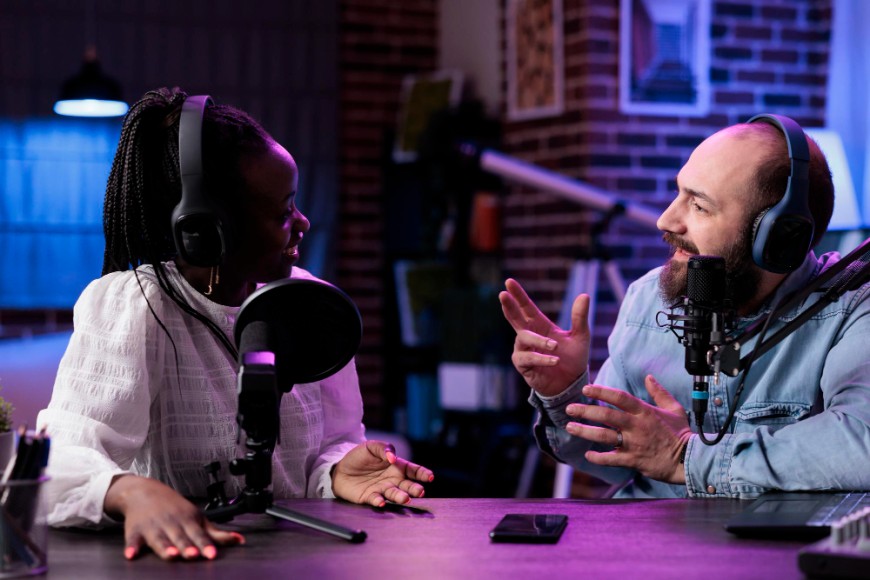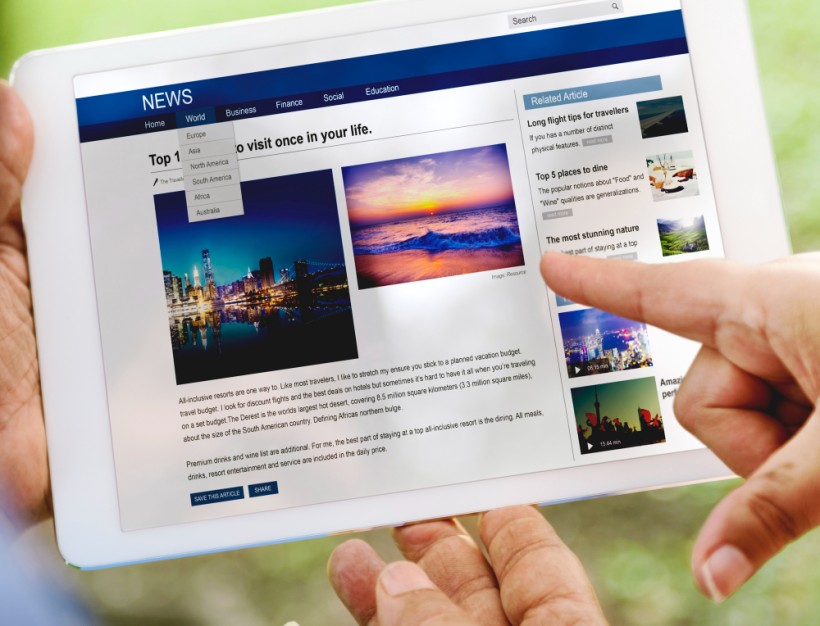Every year, hundreds of business podcasts launch with energy and fade just as fast. They sound great, feature smart guests, and still vanish without a trace. The problem isn’t the content, but the marketing. Many teams assume that publishing on Spotify or Apple is enough. It isn’t.
Podcasting has grown into a serious marketing channel, with over three million active shows and more than 40% of internet users listening each month. For B2B brands, podcasts are powerful because they hold attention. Listeners often tune in for 20 to 45 minutes, long enough to build trust and share expertise in a way no ad or post can. And podcast audiences are more likely to trust brand messages than those exposed to other forms of advertising.
Still, many shows almost never reach the people who matter. Without defined goals, a distribution plan, or performance tracking, even strong ideas fade into the background.
This guide shows how to fix that — how to plan, promote, and measure a podcast that actually drives results.
What Is B2B Podcast Marketing?
Podcast marketing often involves one of two things:
Marketing your podcast —- getting people to discover, subscribe, and keep listening. It covers everything from how you promote new episodes to how you show up on social media or in search results.
Or marketing through your podcast —- when your show becomes part of your broader marketing strategy. You’re not just building an audience, but using the podcast as a platform to reach potential customers, strengthen relationships, and share your brand’s point of view.
For many B2B companies, the real power comes when those two goals overlap. You want people to find your podcast and see it as a trusted source tied to your brand’s expertise. A show that blends both sides can become one of your most consistent marketing assets.
And while big audiences grab attention, smaller, well-targeted ones often deliver more value. A podcast with a few hundred regular listeners who match your ideal customer profile can do more for your brand than one with thousands of casual followers.
That’s why a clear podcast marketing plan is key. It’s what helps you define who you’re talking to, why you’re talking to them, and how each episode supports your larger marketing goals.
How to Build a B2B Podcast Marketing Strategy Before Launch
Before you think about microphones, intros, or cover art, you need a plan. To make a real impact, start with a clear purpose and a sense of direction.
Start by asking a few questions:
- What are we trying to achieve — awareness, credibility, leads, or customer loyalty?
- Who are we really talking to, and what do they care about?
- How will we know if it’s working?
A strong podcast strategy sits right at the intersection of your brand goals and your audience’s interests. Maybe you want to position your company as a voice of authority in your space, or you want to give customers a peek behind the curtain, or share real stories from your clients and partners. Each of those goals shapes the type of show you create and how you measure success.
It also pays to think about your options early. Some brands choose to launch their own podcast to control the message and build a loyal audience. Others partner with existing podcasts that already reach their target market. Some even sponsor podcasts to borrow credibility from trusted hosts. Brands like HSBC UK gained traction by sponsoring established podcasts instead of starting from scratch. The key is choosing what fits your goals, budget, and internal bandwidth.
Defining your audience clearly makes everything else easier. The better you understand who you’re trying to reach, like their challenges, vocabulary, and industry context, the easier it is to plan conversations that feel relevant and valuable.
Finally, decide how the podcast connects with your wider marketing efforts. Will you use it to feed your content calendar, support account-based campaigns, or deepen relationships with existing clients? Think through how episodes will link to other channels like social, email, or events, before you launch.
Best Podcast Formats and Content Ideas for B2B Brands
Once you know why your podcast exists and who it’s for, the next step is figuring out what it should sound like. The right format helps you stay consistent, keeps listeners engaged, and makes production manageable.
There’s no one-size-fits-all approach, but most successful business podcasts fall into a few main types:
- Interview shows. These are the most common, and for good reason. Conversations with customers, partners, or industry experts can build credibility and spark useful insights. Nearly 60% of B2B podcasts use this format because it keeps content fresh and adds outside voices.
- Roundtables or panels. Great for teams that want lively discussion or multiple viewpoints. They work especially well for industries where collaboration and debate drive thought leadership.
- Solo or narrative shows. These put one host or storyteller at the center. They’re effective for brands with a strong in-house expert or founder who can carry the show with experience and perspective.
- Case-based storytelling. Using real customer case studies or project stories is one of the best ways to connect marketing and sales narratives. It gives listeners tangible lessons while quietly showing what your brand can do.
Length isn’t as important as relevance and consistency. Most B2B podcasts land somewhere between 20 and 45 minutes, enough time to explore an idea without overstaying their welcome. The more valuable and tightly edited your content, the more likely listeners are to stay to the end.
Topic planning is another place where strategy meets creativity. Keep a running list of themes tied to your audience’s challenges and your brand’s expertise. Then shape those into episode ideas that educate, entertain, or inspire. The best-performing episodes tend to address specific problems or use guest stories that mirror the listener’s own situation.
Finally, choose guests with intention. A well-chosen guest brings knowledge and reach. Their network can extend your podcast’s visibility if you make it easy for them to share episodes. Think of every guest as both a source and a distribution partner.
When you have a clear format, strong topics, and the right guests, your show becomes a trusted conversation your audience looks forward to.
How to Promote and Distribute Your B2B Podcast
You can have the smartest conversations and slickest production in the world, but if no one hears your podcast, it won’t move the needle. That’s why distribution and promotion is crucial, and they need to be built into your plan from the start.
Think of promotion as an engine, not a one-time announcement. Every episode can (and should) generate a handful of assets that travel farther than the full audio. Pull out short video or audio clips, memorable quotes, and key takeaways. Then tailor them for different channels — a 30-second clip for LinkedIn, a quote graphic for email, or a short blog summary for your website. In a Databox survey, 84% of brands said sharing episode clips on social media was their most common promotion tactic.
A strong podcast distribution plan usually includes four key layers:
- Owned channels: Publish every episode on your site and embed the player in blog posts or landing pages. Feature new episodes in your newsletter and email nurture campaigns.
- Shared channels: Encourage guests, partners, and team members to post episodes on their own networks. Create ready-made graphics and links to make sharing easy.
- Earned exposure: Pitch industry blogs or media outlets to cover standout episodes or key insights. Recording on location at events can also get you in front of the right audiences.
- Paid promotion: Test small ad campaigns on platforms like LinkedIn or YouTube to push episodes that highlight your best content or high-value guests.
This is similar to Gini Dietrich’s PESO Model©, which we cover in more detail here.
Many podcasts fail because they rely too heavily on the big directories like Spotify, Apple, Google, and assume people will just find them. In reality, discovery happens where your audience already spends time. For B2B shows, that often means LinkedIn, Slack groups, newsletters, or niche communities.
Guest participation is another big lever. When a guest shares their episode with their own network, it instantly extends your reach to new, relevant audiences. To make this easy, send them a “guest kit” with shareable clips, links, and suggested post copy.
Lastly, remember that promotion isn’t about pushing episodes once and moving on. Keep resurfacing older but relevant content. If you covered a topic that suddenly becomes timely again, promote that episode like it’s new. Smart distribution makes every recording work harder.
Podcast Metrics: How to Measure Podcast Performance and Prove ROI
If you want your podcast to earn a real place in your marketing strategy (and budget), you have to prove what it delivers. That means going beyond vanity numbers like downloads or follower counts and tracking metrics that show how the podcast supports business goals.
Start with engagement. Look at completion rates, how much of each episode people actually listen to, not just total plays. A healthy benchmark in B2B podcasting is a 60–70% completion rate. Tracking repeat listeners and average listening time gives you a better sense of loyalty and audience quality.
Next, connect your podcast to your broader marketing analytics. Use UTM tags and unique URLs in episode descriptions to track traffic to your site. If you mention a downloadable guide, event, or product, link to it with a trackable link so you can see what actions come from listeners.
From there, move to business impact. This is where podcasts in B2B stand apart, because they can influence pipeline even when they don’t drive direct leads. The team at Fame suggests measuring three categories of outcomes:
- Attributed revenue: Deals that can be directly linked to podcast-driven traffic or engagement.
- Influenced pipeline: Opportunities that arose from guests, listeners, or referrals tied to the podcast.
- Retention or relationship lift: Improved customer relationships or loyalty that can be traced back to podcast interactions.
They even outline a simple ROI formula:
(Attributed Revenue + Influenced Pipeline + Retention Uplift – Total Investment) ÷ Total Investment.
The point isn’t to turn podcasting into a spreadsheet exercise, but to show value in the language your stakeholders care about.
It also helps to collect qualitative feedback. Sales teams can track mentions of the podcast in client conversations. Marketers can gather quotes from listeners or guests who credit the show for sparking new partnerships or ideas. These stories are often the clearest proof of impact.
Finally, review performance regularly. Combine data from hosting platforms, web analytics, and your CRM to build a full picture of how the podcast supports awareness, engagement, and pipeline. Treat it like any other channel: experiment, measure, and adjust.
When you can link your podcast back to business results, it becomes a strategic marketing asset that builds credibility and delivers measurable value.
Final Thoughts on B2B Podcast Marketing
You don’t need a massive audience, just the right one. A few hundred engaged listeners can create more value than thousands of casual followers if they fit your target market.
When your podcast is treated as part of your marketing strategy, it becomes one of the most consistent ways to grow visibility, credibility, and long-term relationships.
Column partners with B2B brands to plan and distribute podcasts and videos that expand reach, strengthen credibility, and prove marketing impact. Connect with us to build a podcast strategy that gets heard by the people who matter most.

Johnson is a Content Strategist at Column. He helps brands craft content that drives visibility and results. He studied Economics at the University of Ibadan and brings over years of experience in direct response marketing, combining strategy, creativity, and data-backed thinking.
Connect with him on LinkedIn.





